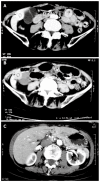A case of laparoscopic hepatectomy for recurrent hepatocellular carcinoma
- PMID: 20101784
- PMCID: PMC2811811
- DOI: 10.3748/wjg.v16.i4.526
A case of laparoscopic hepatectomy for recurrent hepatocellular carcinoma
Abstract
Conventional hepatectomy is an effective way to treat hepatocellular carcinoma. However, it is invasive and stressful. The use of laparoscopy in hepatectomy, while technically demanding, reduces surgical invasiveness and stressfulness but still achieves complete resection with adequate margins. Compared with conventional hepatectomy, laparoscopic hepatectomy provides a better chance and situation for further surgery in the case of recurrence of hepatocellular carcinoma. Even aged patients can successfully endure repeated hepatectomy using laparoscopy, as shown in the present report. This report presents a case of repeated laparoscopic hepatectomy treating hepatocellular carcinoma and its recurrence in an aged patient having cirrhosis, a disease causing extra difficulty for performing laparoscopic hepatectomy. The report also describes techniques of the operation and displays characteristic results of laparoscopic hepatectomy such as smaller wounds, less blood loss, less pain, less scars and adhesion, shorter postoperative hospital stay, and faster recovery.
Figures




Similar articles
-
Prospective, single-center cohort study analyzing the efficacy of complete laparoscopic resection on recurrent hepatocellular carcinoma.Chin J Cancer. 2016 Mar 8;35:25. doi: 10.1186/s40880-016-0088-0. Chin J Cancer. 2016. PMID: 26956022 Free PMC article.
-
Efficacy of laparoscopic surgery for recurrent hepatocellular carcinoma.Hepatogastroenterology. 2012 Jul-Aug;59(117):1333-7. doi: 10.5754/hge12302. Hepatogastroenterology. 2012. PMID: 22591625
-
Laparoscopic redo surgery for recurrent hepatocellular carcinoma in cirrhotic patients: feasibility, safety, and results.Surg Endosc. 2009 Aug;23(8):1807-11. doi: 10.1007/s00464-009-0344-3. Epub 2009 Mar 10. Surg Endosc. 2009. PMID: 19277781
-
Retroperitoneal laparoscopic hepatectomy of recurrent hepatocellular carcinoma: case report and literature review.BMC Gastroenterol. 2020 Aug 20;20(1):278. doi: 10.1186/s12876-020-01380-2. BMC Gastroenterol. 2020. PMID: 32819277 Free PMC article. Review.
-
Perioperative outcomes comparing laparoscopic with open repeat liver resection for post-hepatectomy recurrent liver cancer: A systematic review and meta-analysis.Int J Surg. 2020 Jul;79:17-28. doi: 10.1016/j.ijsu.2020.03.052. Epub 2020 Mar 30. Int J Surg. 2020. PMID: 32240816
Cited by
-
Surgical treatment for recurrent hepatocellular carcinoma: Current status and challenges.World J Gastrointest Surg. 2023 Apr 27;15(4):544-552. doi: 10.4240/wjgs.v15.i4.544. World J Gastrointest Surg. 2023. PMID: 37206072 Free PMC article. Review.
-
Technical notes on pure laparoscopic isolated caudate lobectomy for patient with liver cancer.Transl Gastroenterol Hepatol. 2016 Jul 1;1:56. doi: 10.21037/tgh.2016.06.06. eCollection 2016. Transl Gastroenterol Hepatol. 2016. PMID: 28138623 Free PMC article.
-
Laparoscopic liver resection for hepatocellular carcinoma in patients with cirrhosis.Hepatobiliary Surg Nutr. 2015 Dec;4(6):406-10. doi: 10.3978/j.issn.2304-3881.2015.06.12. Hepatobiliary Surg Nutr. 2015. PMID: 26734625 Free PMC article. Review.
-
Surgical resection of localized hepatocellular carcinoma: patient selection and special consideration.J Hepatocell Carcinoma. 2016 Dec 28;4:1-9. doi: 10.2147/JHC.S96085. eCollection 2017. J Hepatocell Carcinoma. 2016. PMID: 28097107 Free PMC article. Review.
-
Synchronous resections of primary colorectal tumor and liver metastasis by laparoscopic approach.World J Hepatol. 2013 Jun 27;5(6):298-301. doi: 10.4254/wjh.v5.i6.298. World J Hepatol. 2013. PMID: 23805353 Free PMC article.
References
-
- Ardito F, Tayar C, Laurent A, Karoui M, Loriau J, Cherqui D. Laparoscopic liver resection for benign disease. Arch Surg. 2007;142:1188–1193; discussion 1193. - PubMed
-
- Descottes B, Lachachi F, Durand-Fontanier S, Sodji M, Pech de Laclause B, Valleix D. [Laparoscopic treatment of solid and cystic tumors of the liver. Study of 33 cases] Ann Chir. 2000;125:941–947. - PubMed
Publication types
MeSH terms
LinkOut - more resources
Full Text Sources
Medical

